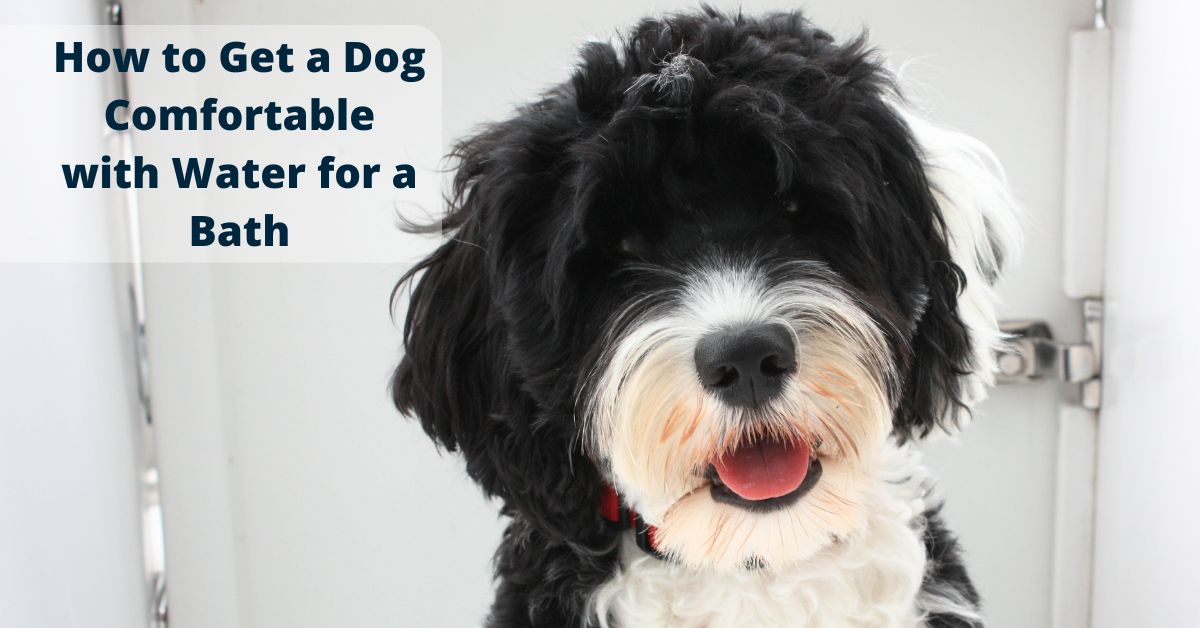How to Get a Dog Comfortable with Water for a Bath
Over the past few weeks we've talked about the differences between dry dog shampoo and waterless dog shampoo, and focused on the potentially toxic ingredients in waterless dog shampoo.
We also provided a DIY recipe for a dry shampoo you can make at home in-between baths for rare times when a proper water bath isn’t an option.
What do you do when your dog is afraid of water so you feel like you have no choice but to use these products that don't do a good job of cleaning off environmental toxins, cleaning the skin, and opening the skin pores?
If your dog is scared of the bath water or hates water. If your dog is afraid of the bath, scared of the shower, or runs away at the sound of the faucet, don't worry, you're not alone.
Here's how to make giving your dog a bath less stressful and help your dog get comfortable with bath time.
Understanding Your Dog's Fear of Water
Before diving into how to bathe a dog who hates water, it's important to understand why some dogs are afraid of water. Loud noises, slippery surfaces, and the unfamiliar sensation of water can all contribute to a dog's anxiety during bath time. By recognizing these triggers, you can modify your approach to help your dog feel more comfortable and happy in the bath.
Desensitizing Your Dog to Water and the Bathtub
-
Start Slow and Steady: Begin at an early age (8 weeks or older) by getting your dog accustomed to being around the bathing area without the pressure of a bath. Use a calm voice, smiles, and tasty treats to encourage your dog to explore the bathroom. Let them sniff the tub and reward them for their bravery. Do this various times a day, for a couple of weeks. This process helps create positive associations with the surroundings that are separate from bath time.
- Introduce the Water Gradually: The next part of desensitizing your dog to water and getting a bath, is teaching him that water is not only ok but a positive experience. Do this training exercise in a separate room, as the bathroom is likely a bit mentally uncomfortable for him. Start with a shallow bowl of water and let your dog investigate. Probably no big deal, right? And that's the point. Reward him with treats for showing interest.
Next, wet a washcloth with water. Just like the bowl of water, reward your dog for investigating. A nice treat, lots of praise, make it fun. Next, gently touch your dog with the wet cloth, reward, praise, and have a little party. You want your dog to think this is a pretty neat activity, full of tasty snacks and my human being silly and fun. Gradually, increase the amount of water on your washcloth, to the point it starts to get a bit drippy and wet. Continue the praise and party. This won't happen in one session, go at your dog's pace and comfort level. The goal is for your dog to look forward to this new game.
Build on this desensitization for water training, by wiping your dog down with a wet washcloth more than once. So, his body starts to get wet all over.
Familiarize Your Dog with the Shower Hose: Many dogs are scared of the shower due to the noise and sensation of the water spraying from the shower hose. You can slowly teach your dog that this is ok and enjoyable, or you can choose to use a pitcher with water and the washcloth. It's harder with the pitcher, but it might be less stressful for your dog. Even if it's temporary while you work on your desensitization to the shower hose.
Show your dog the hand-held shower hose when it's off, letting him sniff it and rewarding him with treats and praise. And remember, you can never have too many parties! Most dogs enjoy it when their humans get silly! When your dog is happy about the shower hose being turned off, it's time to slowly turn it on. Move the shower hose away from your dog (by the way, your dog is not in the bath), and turn it on low, while rewarding your dog. Turn it off. On, reward, off. This allows your dog to slowly get used to the sound. It’s also a good technique in the beginning to just have your dog with you in the bathroom when you are taking a shower. This will also help with sound desensitization. When your dog is comfortable with the sound, gradually turn the hose on regular power, but use a soft stream. Once your dog is happy about this process, you can start to bring the hose closer to your dog. But, he's still not in the tub.
Tips for Bathing Your Dog
- Use a Nonskid Bath Mat: A secure surface can help reduce your dog's anxiety. Place a nonskid bath mat in the tub to prevent slipping and provide a stable footing. This helps your dog feel more secure and reduces their fear of the tub.
- Keep the Water Warm and Gentle: Dogs are more likely to be afraid of a bath if the water is too cold or the pressure is too high. Use warm water and a gentle stream to make the experience more pleasant. A hand-held shower hose with adjustable settings is ideal for controlling the water flow.
- Introduce the Bath Slowly: When it's time for the tub, gently lift your dog into the tub and let them stand on the nonskid mat. Praise them and offer treats for staying calm. Then, take your dog out of the tub. Think of this as another step in the training process. As your dog starts to be happy and comfortable in the tub, turn the hose on slowly. Start by wetting their feet and legs, gradually moving up their body while speaking soothingly and giving treats. Be sure to keep the sprayer close to their body. This will minimize splatter and splashes which are unexpected and may be scary for dogs. You may not give a full bath in the beginning. Short and sweet.
- Distract with Tasty Treats: Keep your dog engaged and content during bathtime by using a licky mat attached to the tub, loaded with his favorite sticky treats. This allows your dog to lick the treats while you bathe him. This continues to teach your dog that good things happen during bathtime. If your dog won't lick the treat, either the treat isn't tasty enough, or you need to go back to a bit more desensitization training mentioned above.
How to Make Bath Time Less Stressful for a Dog
Be Patient and Positive: Don't rush things. Move at your dog's pace, making sure he is comfortable before moving on to the next step. Use lots of praise and treats to reward his bravery and cooperation.
Watch Their Comfort Level: Keep an eye on your dog's body language during the bath. If he seems stressed or panicked, take a break. Gradual, positive experiences will help build his confidence over time.
Stay Consistent: Creating a routine helps your dog know what to expect. Stick to the same steps each time you bathe your dog to make the process predictable and reassuring.
By following these steps, you can help your dog overcome their fear of baths, desensitize them to water, and turn bath time into a positive experience. With patience, consistency, and plenty of treats, your dog will soon learn to tolerate and even enjoy their baths.





